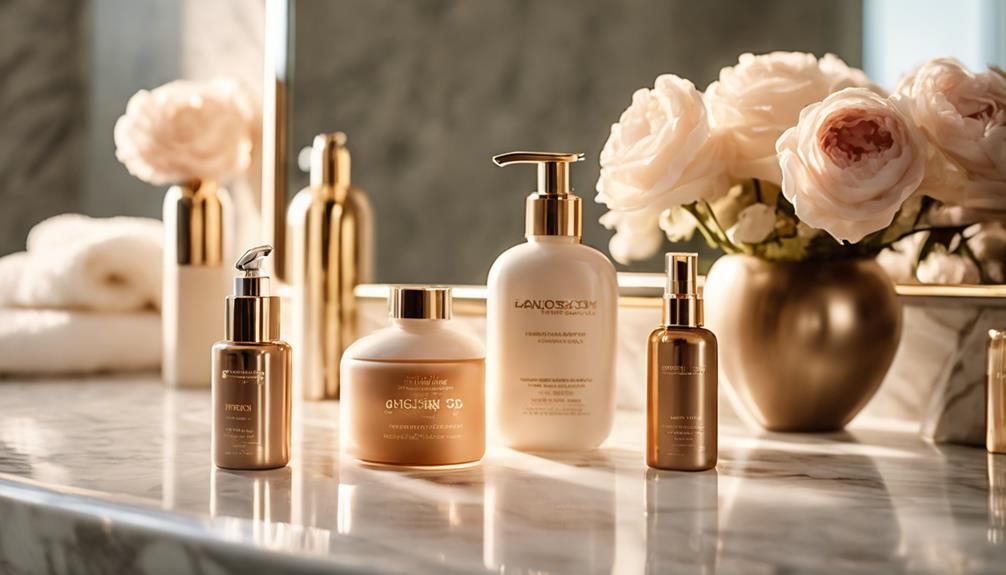Timing your outfit after getting a tan is crucial to maintaining that perfect glow. It is recommended to wait at least 1-2 hours for the self-tanner to completely dry and avoid any contact with water during this time. When it comes to dressing, opt for dark, loose-fitting cotton or breathable fabrics. Avoid tight clothing that could potentially ruin your tan and instead go for flowy dresses or oversized tees for comfort. Choosing easy-on shoes is also a wise decision as they will not disrupt your freshly tanned feet. By following these simple steps, you can ensure a long-lasting, even tan. Keep reading to discover more tips for preserving your beautiful color!
Key Takeaways
- Wait at least 1-2 hours after applying self-tanner before getting dressed to ensure it dries properly and avoids smudging.
- Choose dark, loose-fitting cotton or breathable fabrics to prevent disruption of the tan and allow for airflow.
- Maintain a calm environment to avoid hurried movements that could lead to uneven results on the tan.
- Opt for flowy dresses or oversized tees to keep skin unrestricted and comfortable while preserving the tan quality.
Timing and Drying Techniques
Timing is essential right after applying self-tanner, so give it 1-2 hours to dry and set properly for the best results. During this time, avoid any water exposure to preserve the integrity of your tan.
If you're keen to speed up the drying process, using a fan can help enhance tan development. Remember to practice patience; rushing can lead to uneven results.
After your tan has dried, regular moisturization will help maintain your glow and prolong its life. Treat your tan like a treasure, ensuring it remains flawless by allowing adequate time for it to set.
With proper timing and care, you'll achieve that perfect bronzed look you desire!
Ideal Clothing Choices
After your tan has dried, the right clothing choices can make all the difference in maintaining that flawless bronzed look.
Opt for dark, loose-fitting cotton or breathable fabrics to prevent streaks and smudging. Tight clothing can disrupt your tan, so choose flowy dresses or oversized tees for comfort and style.
When it comes to footwear, select easy-on shoes to avoid disturbing any tan on your feet.
For nighttime, go for loose, dark sleepwear and consider using a sheet protector to prevent any tan transfer while you sleep.
Best Practices for Maintenance

To keep your tan looking fresh and vibrant, prioritize regular moisturization and choose loose, dark clothing that protects your skin. Following these best practices will help maintain your bronzed glow:
- Hydrate Daily: Use a rich moisturizer after showering to lock in hydration and extend the life of your tan.
- Bedding Protection: Employ a sheet protector to prevent tan transfer while sleeping, ensuring you wake up without streaks.
- Confidence in Style: Embrace your tan by wearing outfits that make you feel good, like flowy dresses or oversized shirts, while keeping skin covered.
Understanding Tan Development
Maintaining a stunning tan starts with understanding how it develops, so you can optimize your application and enjoy a flawless finish.
Timing is essential; self-tanners vary in drying times, so you'll want to follow product guidelines closely. After applying the tan, resist the urge to rush—give it 1-2 hours to dry completely.
During this time, wear loose, dark clothing to avoid disrupting the tan. Fabric choice matters; breathable materials help your skin stay comfortable while preventing streaks.
Avoid water exposure during this setting period, as it can spoil your hard work. Treat your tan like a treasure, nurturing it with care and patience to achieve that gorgeous, even glow you desire.
Tips for Dressing After Tanning

How can you guarantee your fresh tan stays flawless while getting dressed? Follow these tips to keep your bronzed skin looking its best:
- Wait to Dress: Allow your tan to fully set for at least 1-2 hours before putting on clothes. This helps prevent smudges and streaks.
- Choose the Right Fabrics: Opt for dark, loose-fitting cotton or breathable fabrics. Avoid tight or synthetic materials, which can disrupt the tan.
- Stay Relaxed: Maintain a calm environment while your tan dries. Stress can lead to hurried movements that might ruin your glow.
How Can I Time My Post-Tan Wardrobe to Maintain My Wedding Glow?
Timing your post-tan wardrobe to maintain your perfect wedding glow timeline is possible with some planning. Opt for light, airy fabrics to avoid tan lines and ensure your glow lasts. Choose neutral colors that complement your tan, and don’t forget to accessorize with statement pieces to enhance your bridal radiance.
Conclusion
As you bask in your radiant glow, think of your post-tan wardrobe as a protective cocoon, cradling your sun-kissed skin.
By choosing loose, breathable fabrics and allowing your tan to fully develop, you're nurturing your vibrant transformation.
Just like a butterfly emerging from its chrysalis, your flawless tan deserves the freedom to shine without restraint.
Embrace this moment, and let your bronzed beauty flourish, reflecting the warmth and confidence you carry within.










